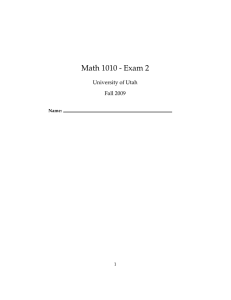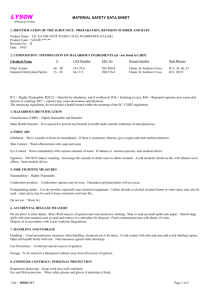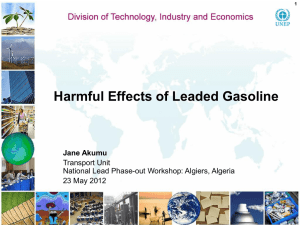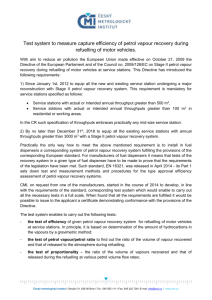Unleaded Petrol SDS: Safety, Hazards & Handling
advertisement
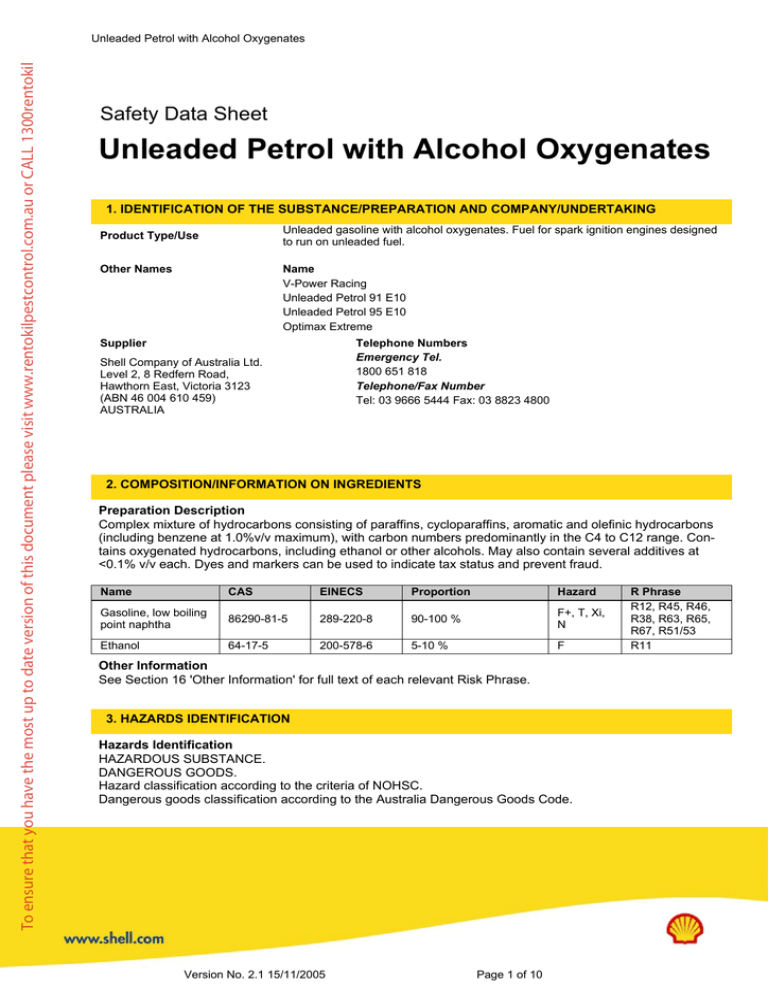
To ensure that you have the most up to date version of this document please visit www.rentokilpestcontrol.com.au or CALL 1300rentokil Unleaded Petrol with Alcohol Oxygenates Safety Data Sheet Unleaded Petrol with Alcohol Oxygenates 1. IDENTIFICATION OF THE SUBSTANCE/PREPARATION AND COMPANY/UNDERTAKING Unleaded gasoline with alcohol oxygenates. Fuel for spark ignition engines designed to run on unleaded fuel. Product Type/Use Other Names Name V-Power Racing Unleaded Petrol 91 E10 Unleaded Petrol 95 E10 Optimax Extreme Supplier Telephone Numbers Emergency Tel. 1800 651 818 Telephone/Fax Number Tel: 03 9666 5444 Fax: 03 8823 4800 Shell Company of Australia Ltd. Level 2, 8 Redfern Road, Hawthorn East, Victoria 3123 (ABN 46 004 610 459) AUSTRALIA 2. COMPOSITION/INFORMATION ON INGREDIENTS Preparation Description Complex mixture of hydrocarbons consisting of paraffins, cycloparaffins, aromatic and olefinic hydrocarbons (including benzene at 1.0%v/v maximum), with carbon numbers predominantly in the C4 to C12 range. Contains oxygenated hydrocarbons, including ethanol or other alcohols. May also contain several additives at <0.1% v/v each. Dyes and markers can be used to indicate tax status and prevent fraud. Name CAS EINECS Proportion Hazard Gasoline, low boiling point naphtha 86290-81-5 289-220-8 90-100 % F+, T, Xi, N Ethanol 64-17-5 200-578-6 5-10 % F Other Information See Section 16 'Other Information' for full text of each relevant Risk Phrase. 3. HAZARDS IDENTIFICATION Hazards Identification HAZARDOUS SUBSTANCE. DANGEROUS GOODS. Hazard classification according to the criteria of NOHSC. Dangerous goods classification according to the Australia Dangerous Goods Code. Version No. 2.1 15/11/2005 Page 1 of 10 R Phrase R12, R45, R46, R38, R63, R65, R67, R51/53 R11 To ensure that you have the most up to date version of this document please visit www.rentokilpestcontrol.com.au or CALL 1300rentokil Unleaded Petrol with Alcohol Oxygenates Human Health Hazards Hydrocarbon Components: May cause cancer. Product classified as a Category 2 carcinogen. May cause heritable genetic damage. Product classified as a Category 2 mutagen. Possible risk of harm to the unborn child. Product is classified as a Category 3 Reproductive toxicant. Irritating to skin. Harmful, may cause lung damage if swallowed. Vapours may cause drowsiness and dizziness. This product contains benzene, which is known to cause leukaemia and n-hexane, which has been shown to metabolize to compounds which are neuropathic. This product contains toluene. There are indications from animal studies that prolonged exposure to high concentrations of toluene may lead to hearing loss. Safety Hazards Extremely flammable. Risk of generating electrostatic charges during handling. Liquid evaporates quickly and can ignite leading to a flash fire, or an explosion in a confined space. Environmental Hazards Toxic to aquatic organisms. May cause long term adverse effects in the aquatic environment. Unlike other gasoline components, ethanol is miscible with water. Other Information This product is intended for use as a fuel in a closed system. If used for any other purpose, in open systems or as a spray, ignition and exposure risks will increase and a careful risk assessment should be carried out. 4. FIRST AID MEASURES Symptoms and Effects Not expected to give rise to an acute hazard under normal conditions of use. Irritating to skin. Aspiration into the lungs may occur directly or following ingestion. This may cause chemical pneumonitis which may be fatal. Splashes into the eye may cause irritation. Prolonged exposure to vapour concentrations above the recommended occupational exposure standard may cause headache, dizziness, nausea, irritation of the eyes, upper respiratory tract, asphyxiation, unconsciousness and even death. Inhalation Remove to fresh air. If breathing but unconscious, place in the recovery position. If breathing has stopped, apply artificial respiration. If heartbeat absent, give external cardiac compression. Monitor breathing and pulse. Seek urgent medical advice. Skin Wash skin with water using soap if available. Note that contaminated clothing may be a fire hazard. Contaminated clothing should be soaked with water before being removed. It must be laundered before reuse. When using high pressure equipment, injection of product under the skin can occur. If high pressure injuries occur, the casualty should be sent immediately to a hospital. Do not wait for symptoms to develop. Eye Flush eye with copious quantities of water. If persistent irritation occurs, obtain medical attention. Ingestion DO NOT INDUCE VOMITING. Protect airway if vomiting begins. Give nothing by mouth. If breathing but unconscious, place in recovery position. If breathing has stopped, apply artificial respiration. OBTAIN MEDICAL ATTENTION IMMEDIATELY. Advice to Doctor Treat symptomatically. In cases of ingestion, consider gastric lavage. Gastric lavage must only be undertaken after cuffed endotracheal intubation in view of the risk of aspiration. Administration of carbon for medicinal use (carbo medicinalis) may reduce absorption from the digestive tract. In cases of chemical pneumonitis, antibiotic and corticosteroid therapy should be considered, but only under expert guidance and with special care facilities. High pressure injection injuries require prompt surgical intervention and possibly steroid therapy, to minimise tissue damage and loss of function. Version No. 2.1 15/11/2005 Page 2 of 10 To ensure that you have the most up to date version of this document please visit www.rentokilpestcontrol.com.au or CALL 1300rentokil Unleaded Petrol with Alcohol Oxygenates 5. FIRE FIGHTING MEASURES Specific Hazards Combustion is likely to give rise to a complex mixture of airborne solid and liquid particulates and gases, including carbon monoxide and unidentified organic and inorganic compounds. The vapour is heavier than air, spreads along the ground and distant ignition is possible. Will float and may be reignited on surface water. Extinguishing Media Foam, fine water spray and dry chemical powder. Carbon dioxide, Clean Agents (e.g. Inergen, Argonite etc.), sand or earth may be used for small fires only. Unsuitable Extinguishing Media Do not use water in a jet. Protective Equipment Proper protective equipment must be worn, this should include breathing apparatus when approaching a fire in a confined space. Other Information Keep adjacent drums and tanks cool by spraying with water from a safe location. If possible remove them from the danger zone. If adequate cooling cannot be achieved, the area needs to be evacuated, and further fire fighting and cooling attempts should be carried out from a safe location. 6. ACCIDENTAL RELEASE MEASURES Personal Precautions Vapour can travel for considerable distances both above and below the ground surface. Underground services (drains, pipelines, cable ducts) can provide preferential flow paths. Remove all possible sources of ignition in the surrounding area. Evacuate all personnel. Contaminated clothing may be a fire hazard and therefore should be soaked with water before being removed. Ventilate contaminated area thoroughly. Do not breathe fumes, vapour. Do not operate electrical equipment. Avoid contact with skin, eyes, clothing. Wear chemical resistant knee length safety boots and PVC jacket and trousers. Wear safety glasses or full face shield if splashes are likely to occur. Environmental Precautions Prevent from spreading or entering into drains and surface waters (e.g. lakes, ponds, ditches, rivers and streams) by using sand, earth, or other appropriate non-combustible barriers. Inform local authorities if impacts cannot be prevented. Clean-up Methods - Small Spillages To minimize soil and groundwater contamination, absorb liquid with sand earth or other recommended sorbant material, as soon as safe to do so after the spill. Sweep up and remove to a suitable, clearly marked container for disposal in accordance with local regulations. Do not dispose into an interceptor. Clean-up Methods - Large Spillages Prevent from spreading by making a barrier with sand, earth or other containment material. Dispose of as for small spills. Maritime Spillages Maritime spillages should be dealt with using a Shipboard Oil Pollution Emergency Plan (SOPEP), as required by MARPOL Annex 1 Regulation 26. Other Information Local authorities should be advised if significant spillages cannot be contained. Observe all relevant local regulations. If contamination of sites occurs remediation may require specialist advice. Version No. 2.1 15/11/2005 Page 3 of 10 To ensure that you have the most up to date version of this document please visit www.rentokilpestcontrol.com.au or CALL 1300rentokil Unleaded Petrol with Alcohol Oxygenates 7. HANDLING AND STORAGE Exposures in Normal Use Vehicle fuelling and vehicle workshop areas - Avoid inhalation of vapours and contact with skin, when filling or emptying a vehicle. Handling Never siphon by mouth. When using do not eat, drink or smoke. Avoid contact with skin, eyes and respiratory system. If using pressurised equipment, take extra care to avoid injection under the skin. Only use in wellventilated areas. Take precautionary measures against static discharges. Ensure all equipment is properly earthed. Use local exhaust ventilation if there is risk of inhalation of vapours, mists or aerosols. When handling product in drums, safety footwear should be worn and proper handling equipment should be used. Prevent spillages. Cloth, paper and other materials that are used to absorb spills present a fire hazard. Avoid their accumulation by disposing of them safely and immediately. In addition to any specific recommendations given for controls of risks to health, safety and the environment, an assessment of risks must be made to help determine controls appropriate to local circumstances. Storage This product must never be stored in buildings occupied by people. Small volumes (maximum 5 litres), may be stored in a suitably designed portable container. Such containers should be stored in well-ventilated areas, flameproof cabinets or stores. Use properly labelled and closeable containers. Keep container tightly closed in a dry, well-ventilated place away from direct sunlight and other sources of heat or ignition. Take suitable precautions when opening sealed containers, as pressure can build up during storage. Keep in a bunded area with a sealed (low permeability) floor, to provide containment against spillage. Prevent ingress of water. Stack drums to a height not exceeding 3 metres without the use of racking. Locate tanks away from heat and other sources of ignition. Seek specialist advice for the design, construction and operation of bulk storage facilities. Storage Temperatures Ambient. Product Transfer Electrostatic charges may be generated during pumping. Ensure electrical continuity by bonding all equipment. Avoid splash filling. Wait 2 minutes after tank filling (for tanks such as those on road tanker vehicles) before opening hatches or manholes. Wait 30 minutes after tank filling (for large storage tanks) before opening hatches or manholes. Tank Cleaning Cleaning, inspection and maintenance of storage tanks is a specialist operation that requires the implementation of strict procedures and precautions. These include issuing of work permits, gas-freeing of tanks, using a manned harness, lifelines, and wearing air-supplied breathing apparatus. Prior to entry and whilst cleaning is underway, the atmosphere within the tank must be monitored using an oxygen meter and explosimeter. Additional precautions are required where the tank may previously have contained leaded gasoline. Recommended Materials For containers or container linings, use mild steel or stainless steel. Aluminium may also be used for applications where it does not present an unnecessary fire hazard. Examples of suitable materials are: high density polyethylene (HDPE), polypropylene (PP), and Viton (FKM), which have been specifically tested for compatibility with this product. For container linings, use amine-adduct cured epoxy paint. For seals and gaskets use: graphite, PTFE, Viton A, Viton B. Unsuitable Materials Synthetic materials such as plastics and fibreglass may be unsuitable for containers or container linings depending on the material specification and intended use. Examples of materials to avoid are: natural rubber (NR), nitrile rubber (NBR), ethylene propylene rubber (EPDM), polymethyl methacrylate (PMMA), polystyrene, polyvinyl chloride (PVC), polyisobutylene. However, some may be suitable for glove materials. Other Information Ensure that all local and international regulations regarding handling and storage facilities are followed. Version No. 2.1 15/11/2005 Page 4 of 10 To ensure that you have the most up to date version of this document please visit www.rentokilpestcontrol.com.au or CALL 1300rentokil Unleaded Petrol with Alcohol Oxygenates The following activities have been associated with high levels of exposure to gasoline vapours: Top-loading of tankers, open ship loading by deck crew, drum filling/emptying and laboratory testing (particularly sample bottle washing). 8. EXPOSURE CONTROLS, PERSONAL PROTECTION Exposure Limits Substance Regulations Ethanol NOHSC:1003 NOHSC:1003 NOHSC:1003 Exposure Duration TWA TWA Exposure Limit Units 1000 1880 ppm mg/m3 Notes Adopted National Exposure Standards for Atmospheric Contaminants in the Occupational Environment [NOHSC:1003(1995)] - 3rd Edition Exposure Controls The level of personal protection and the types of controls necessary will vary depending on exposure conditions. Select controls based on a risk assessment of local circumstances. Use sealed systems as far as possible. Use local, intrinsically safe, exhaust ventilation if there is a risk of inhalation of vapours, mists, or aerosols. Provide eye washes and showers for emergency use. Respiratory Protection Care should be taken to keep exposures below applicable occupational exposure limits. If this cannot be achieved, use of a respirator fitted with an organic vapour cartridge combined with a particulate pre-filter should be considered. Where air-filtering respirators are unsuitable (e.g. where airborne concentrations are high, there is a confined space or a risk of oxygen deficiency) use appropriate positive pressure breathing apparatus. Hand Protection Select gloves tested to a relevant standard (e.g. Europe EN374, US F739). When prolonged or frequent repeated contact occurs, Nitrile gloves may be suitable. (Breakthrough time of > 240 minutes). For incidental contact/splash protection Neoprene or PVC gloves may be suitable. Breakthrough times for gloves varies depending on, e.g. chemical resistance, material thickness, frequency and duration of contact. Selection should also take into account other usage requirements, e.g. dexterity, heat resistance, other chemical substances handled. Always seek advice from glove suppliers. Contaminated gloves should be replaced. Personal hygiene is a key element of effective hand care. Gloves must only be worn on clean hands. After using gloves, hands should be washed and dried thoroughly. Application of a non-perfumed moisturizer is recommended. Eye Protection Wear safety glasses or full face shield if splashes are likely to occur. Body Protection Minimise all forms of skin contact. In the event of risk from splashing wear e.g. Nitrile, PVC, or neoprene rubber apron. Wear safety shoes or boots which are chemical and petroleum distillate resistant. Environmental Exposure Controls Minimise release to the environment. An environmental assessment must be made to ensure compliance with local environmental legislation. Exposure Measurement Methods Monitoring of the concentration of substances in the breathing zone of workers or in the general workplace may be required to confirm compliance with an Occupational Exposure Limit and adequacy of exposure controls. For some substances biological monitoring may also be appropriate. Information on suitable methods is available on request. 9. PHYSICAL AND CHEMICAL PROPERTIES Colour Colourless/pale straw/yellow. Version No. 2.1 15/11/2005 Page 5 of 10 To ensure that you have the most up to date version of this document please visit www.rentokilpestcontrol.com.au or CALL 1300rentokil Unleaded Petrol with Alcohol Oxygenates Form Physical State Odour pH Value Vapour Pressure Initial Boiling Point Final Boiling Point Solubility in Water Density Flash Point Flammable Limits - Upper Flammable Limits - Lower Auto-Ignition Temperature Kinematic Viscosity Vapour Density (Air=1) Partition co-efficient, n-octanol/water Other Information Liquid Liquid. Characteristic. Data not available. 30 to 90 kPa at 20ºC. Vapour pressure is often determined by legislation, and varies with season. circa 25ºC. circa 215ºC. Partly soluble due to the content of oxygenated components. 720 to 775 kg/m3 at 15°C. <-40ºC (Method: PMCC). 6-8%(V/V) maximum. 1%(V/V) minimum. >250ºC. 0.5 to 0.75 mm2/s at 40°C. >3. log Pow 2 to 7. The above properties are generic. There may be parameters for which National Specifications apply. The water solubility of each constituent can be calculated from a multiplication of an individual solubility with its concentration in the gasoline. 10. STABILITY AND REACTIVITY Stability Stable under normal use conditions. Conditions to Avoid Heat, open flames, sparks and flammable atmospheres. Materials to Avoid Strong oxidizing agents e.g. chlorates and ammonium nitrate. Hazardous Decomposition Products Hazardous decomposition products are not expected to form during normal storage. 11. TOXICOLOGICAL INFORMATION Basis for Assessment Fuels are typically made from blending several refinery streams. Toxicological studies have been carried out on a variety of hydrocarbon blends and streams but not those containing additives. Information given is based on a knowledge of available data on the hydrocarbon blends and on a knowledge of the constituents. Acute Toxicity - Oral LD50 > 5000 mg/kg. Ingestion may lead to vomiting and aspiration into the lungs, this may result in chemical pneumonitis, which may be fatal. Acute Toxicity - Dermal LD50 > 2000 mg/kg. Acute Toxicity - Inhalation LC50 expected to be >5mg/l. Vapours may cause drowsiness and dizziness. Eye Irritation Slightly irritating. Version No. 2.1 15/11/2005 Page 6 of 10 To ensure that you have the most up to date version of this document please visit www.rentokilpestcontrol.com.au or CALL 1300rentokil Unleaded Petrol with Alcohol Oxygenates Skin Irritation Irritating. Respiratory Irritation Expected to be slightly irritating. Skin Sensitisation Not a skin sensitizer. Carcinogenicity Inhalation exposure to mice causes liver tumours, which are not considered relevant to humans. Inhalation exposure to rats causes kidney tumours which are not considered relevant to humans. Mutagenicity There is a large database of mutagenicity studies on gasoline and gasoline blending streams, which use a wide variety of endpoints and give predominantly negative results. All in vivo studies in animals and recent studies in exposed humans (e.g. petrol service station attendants) have shown negative results in mutagenicity assays. Reproductive Toxicity Repeated exposure of pregnant rats to high concentrations of toluene (around or exceeding 1000ppm) can cause developmental effects, such as lower birth weight and developmental neurotoxicity, on the foetus. However, in a two-generation reproductive study in rats exposed to gasoline vapour condensate, no adverse effects on the foetus were observed. Human Effects Prolonged/repeated contact may cause defatting of the skin which can lead to dermatitis and may make the skin more susceptible to irritation and penetration by other materials. Other Information This product contains benzene which is known to cause acute myeloid leukaemia and n-hexane which has been shown to metabolize to compounds which are neuropathic. This product contains toluene. There are indications from animal studies that prolonged exposure to high concentrations of toluene may lead to hearing loss. This product contains ethyl benzene and naphthalene from which there is evidence of tumours in rodents. High pressure injection of product into the skin may lead to local necrosis if the product is not surgically removed. 12. ECOLOGICAL INFORMATION Basis for Assessment Fuels are typically made from blending several refinery streams. Ecotoxicological studies have been carried out on a variety of hydrocarbon blends and streams but not those containing additives. Information given is based on a knowledge of the components and the ecotoxicology of similar products. Mobility Floats on water. Contains volatile components. Evaporates within a day from water or soil surfaces. Large volumes may penetrate soil and could contaminate groundwater. Persistence / Degradability Major components are inherently biodegradable. Persists under anaerobic conditions. The volatile components oxidise rapidly by photochemical reactions in air. Bioaccumulation Contains components with the potential to bioaccumulate. Ecotoxicity Product is classified as toxic to aquatic organisms, LL/EL50 1 -10 mg/l. (LL/EL50 expressed as the nominal amount of product required to prepare aqueous test extract). Films formed on water may affect oxygen transfer and damage organisms. Version No. 2.1 15/11/2005 Page 7 of 10 To ensure that you have the most up to date version of this document please visit www.rentokilpestcontrol.com.au or CALL 1300rentokil Unleaded Petrol with Alcohol Oxygenates 13. DISPOSAL CONSIDERATIONS Waste Disposal Waste arising from a spillage or tank cleaning should be disposed of in accordance with prevailing regulations, preferably to a recognised collector or contractor. The competence of the collector or contractor to deal satisfactorily with this type of product should be established beforehand. Do not dispose into the environment, in drains or in water courses. Do not dispose of tank water bottoms by allowing them to drain into the ground. This will result in soil and groundwater contamination. Product Disposal As for waste disposal. Container Disposal Recycle or dispose of in accordance with the legislation in force with a recognised collector or contractor. Do not pollute the soil, water or environment with the waste product. 14. TRANSPORT INFORMATION ADG U.N. Number 1203 ADG UN Class 3 ADG Packing Group II ADG Hazchem Code 3[Y]E ADG Proper Shipping Name GASOLINE IMDG UN Number 1203 IMDG Hazard Class 3 IMDG Packing Group II IMDG Proper Shipping Name GASOLINE IATA UN Number 1203 IATA Hazard Class 3 IATA Packing Group II IATA Proper Shipping Name GASOLINE Packaging Method 5.9.3RT1 Other Information Not a Marine Pollutant under IMDG. MARPOL rules apply for bulk shipments by sea. Version No. 2.1 15/11/2005 Page 8 of 10 To ensure that you have the most up to date version of this document please visit www.rentokilpestcontrol.com.au or CALL 1300rentokil Unleaded Petrol with Alcohol Oxygenates 15. REGULATORY INFORMATION EC Symbols EC Risk Phrase EC Safety Phrase F+ T N R12 Extremely Flammable. R38 Irritating to skin. R45 May cause cancer. R46 May cause heritable genetic damage. R51/53 Toxic to aquatic organisms, may cause long-term adverse effects in the aquatic environment. R63 Possible risk of harm to the unborn child. R65 Harmful: may cause lung damage if swallowed. R67 Vapours may cause drowsiness and dizziness S2 Keep out of reach of children. S23(4) Do not breathe vapour. S24 Avoid contact with skin. S29 Do not empty into drains. S43(3) In case of fire use fine water spray/alcohol resistant foam/dry powder/CO2. S45 In case of accident or if you feel unwell seek medical advice immediately S53 Avoid exposure - obtain special instructions before use. S61 Avoid release to the environment. Refer to special instructions/safety data sheet. S62 If swallowed, do not induce vomiting; seek medical advice immediately and show this container or label. AICS (Australia) All components listed. National Legislation National Code of Practice for the Preparation of Material Safety Data Sheets [NOHSC:2011] List of Designated Hazardous Substances [NOHSC:10005]. Approved Criteria for Classifying Hazardous Substances [NOHSC:1008]. Adopted National Exposure Standards for Atmospheric Contaminants in the Occupational Environment [NOHSC:1003]. Australian Dangerous Goods Code. Standard Uniform Scheduling of Drugs and Poisons. Hazard Category Harmful, Irritant, Carcinogenic (Category 2), Mutagen (Category 2), Extremely Flammable, Dangerous for the environment, Toxic for reproduction development Category 3 Packaging & Labelling Contains gasoline, low boiling point naphtha, unspecified. 16. OTHER INFORMATION Revisions Highlighted No amendments made to information. 2. COMPOSITION/INFORMATION ON INGREDIENTS - Dangerous Components / Constituents 3. HAZARDS IDENTIFICATION - Human Health Hazards 11. TOXICOLOGICAL INFORMATION - Mutagenicity 11. TOXICOLOGICAL INFORMATION - Reproductive Toxicity 15. REGULATORY INFORMATION - EC Risk Phrase SDS Distribution This document contains important information to ensure the safe storage, handling and use of this product. The information in this document should be brought to the attention of the person in your organisation responsible for advising on safety matters. References For detailed advice on Personal Protective equipment, refer to the following Australian Standards :- Version No. 2.1 15/11/2005 Page 9 of 10 To ensure that you have the most up to date version of this document please visit www.rentokilpestcontrol.com.au or CALL 1300rentokil Unleaded Petrol with Alcohol Oxygenates HB 9 (Handbook 9) Manual of industrial personal protection. AS/NZS 1337 Eye protectors for industrial applications. AS/NZS 1715 Selection, use and maintenance of respiratory protective devices. AS/NZS 1716 Respiratory protective devices. Poisons Schedule S5. Restrictions This product must not be used in applications other than those recommended without first seeking the advice of the supplier. This product is not to be used as a solvent or cleaning agent, for lighting or brightening fires, or as a skin cleanser. List of R Phrases in Section 2 R11 Highly flammable. R12 Extremely Flammable. R38 Irritating to skin. R45 May cause cancer. R46 May cause heritable genetic damage. R63 Possible risk of harm to the unborn child. R65 Harmful: may cause lung damage if swallowed. R67 Vapours may cause drowsiness and dizziness R51/53 Toxic to aquatic organisms, may cause long-term adverse effects in the aquatic environment. Technical Contact Numbers (03) 9666 5444. Further Information This information is based on our current knowledge and is intended to describe the product for the purposes of health, safety and environmental requirements only. It does not constitute a guarantee for any specific property of the product. ... End Of SDS ... Version No. 2.1 15/11/2005 Page 10 of 10
